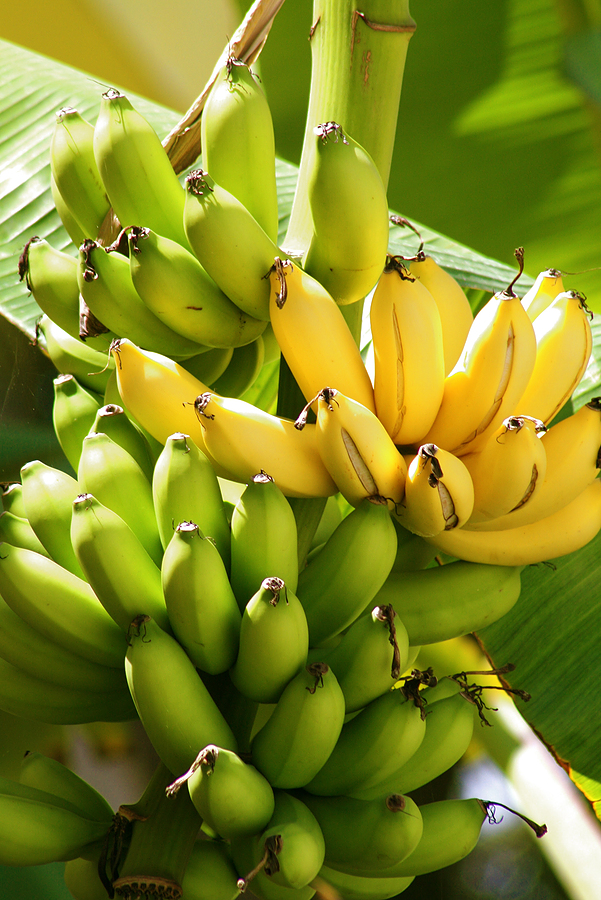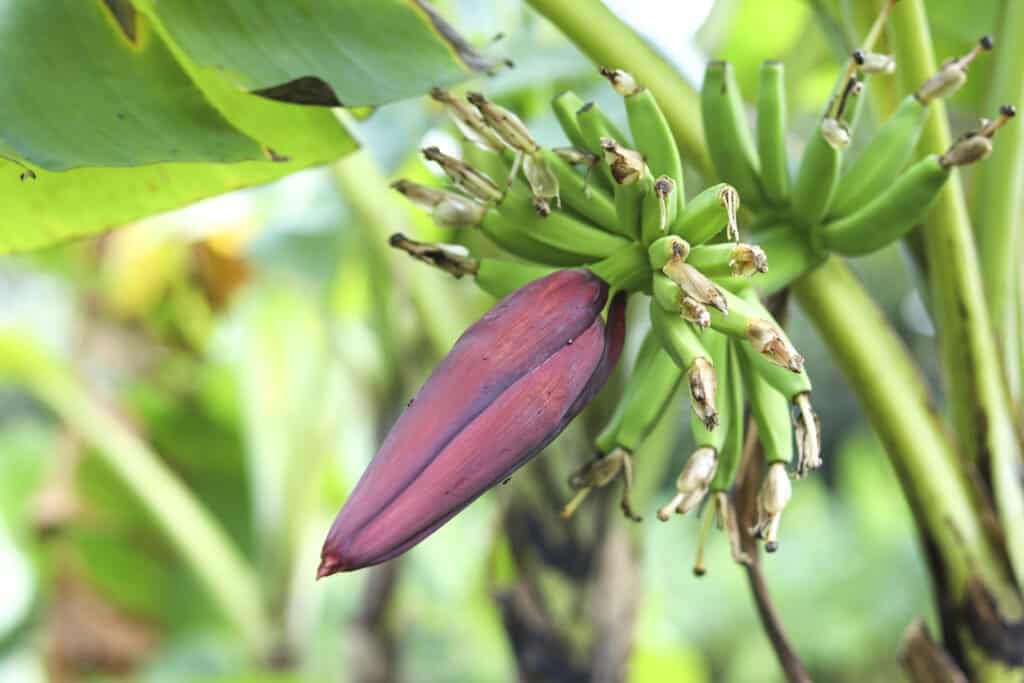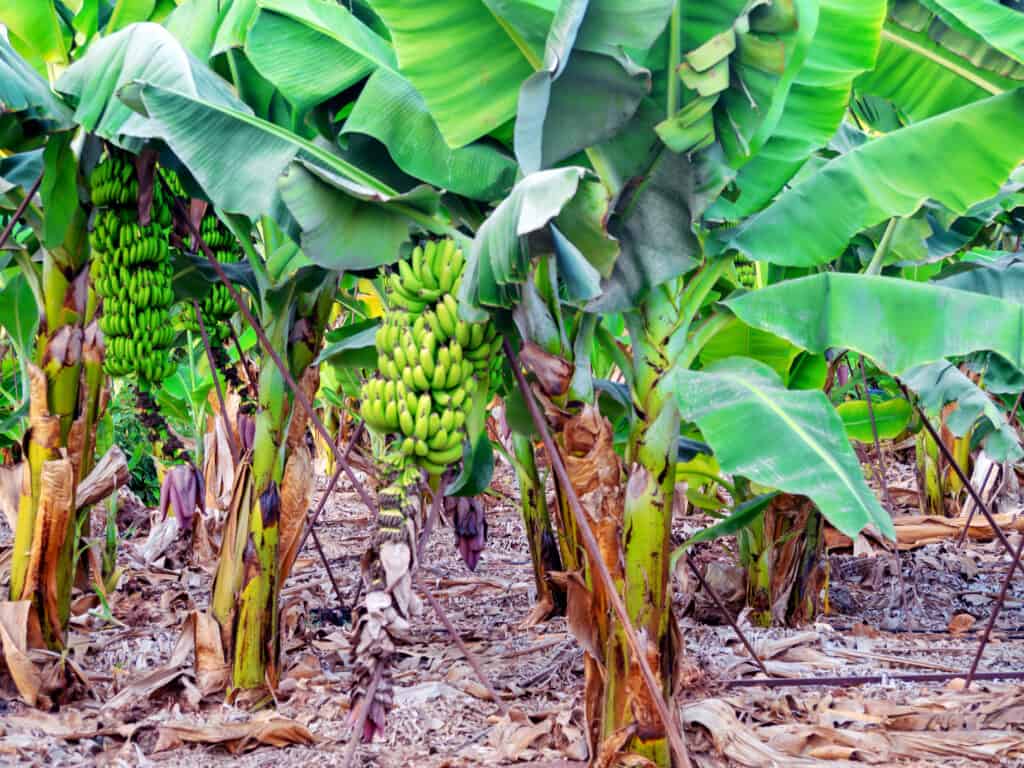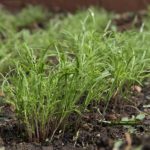Bananas are a staple food in most tropical countries. Banana plants have been domesticated plants for thousands of years. Bananas are a staple food in most tropical and many subtropical countries.
Edible banana species have been crossed and recrossed for centuries resulting in two main types of banana–the sweet, dessert banana and the starchier, cooking banana. Musa acuminata is a sweet, fresh-eating banana. Musta balbisiana is the starchier cooking banana.
Related article:
Bananas are not difficult to grow, but the climate and conditions must be right.
Fruiting banana plants require temperatures that average about 80°F (26°C) during the day and about 70°F (21°C) at night. Constant humidity of about 50 percent and daylight of around twelve hours each day is ideal. Bananas will fruit in less than ideal conditions but the quality of the fruit will suffer.

Bananas grow from rhizomes in much the same way as potatoes. While they are herbaceous perennials, they grow to a tree-like size in a single season. The trunk of a banana plant is not woody, it is a series of overlapping stalks that grow up around each other forming a nearly hollow tube.
Bananas are commonly picked green. When bananas are allowed to ripen on the plants, they spoil. Ripened off the plant at room temperature, bananas can be eaten fresh or cooked. They can be steamed, boiled, fried, or baked. Bananas can also be dried and frozen.
The banana can be grown as a houseplant in a large container. It will need plenty of natural light and must be protected from cooler temperatures in the winter months. A banana houseplant is unlikely to produce edible fruit.
Good Products At Amazon For Banana Growing Success:
Here is your complete guide to growing banana trees!
Two types of bananas
There are two types of bananas: dessert bananas which are commonly eaten out-of-hand and in various desserts, and cooking bananas which are starchy and almost exclusively used for cooking. Cooking bananas include plantains.
- Dessert bananas are the common yellow bananas. They are yellow and generally about 7 to 9 inches long and about 1½ inches in diameter. When ripe, the flesh is moist, slightly sticky, soft, and sweet.
- Cooking bananas resemble yellow bananas, but they are larger and thicker-skinned with three or four well-defined sides. They are green when unripe, turning yellow, then brown, then black when ripe. They must be cooked to be edible. When cooked they have a mildly sweet flavor similar to winter squash.
Banana basics to know
- Common name: Banana
- Botanical name: Hybrids of Musa acuminata and Musa balbisiana
- Origin: Southeast Asia
- Growth habit: Fast-growing herbaceous perennial, upright 5 to 25 feet; large tropical leaves; spreads by underground rhizomes or corms. A banana is a series of leaf stalks wrapped around each other. New leaves grow from the ground level at the center of the plants; they push up through the center of the plant.
- Requirements: Requires ample fertilizer, water, and heat. Freezing temperatures will kill foliage; rhizomes are hardy to 22°F.
- Harvest time: 4 to 8 months after flowering.
- First fruiting: First fruits come within 12 to 18 months after planting.
- Propagation: By division of rhizomes or from suckers.
- Pollination: Self-fruitful
- Container growing: Easily grown in containers; grow indoors in bright light.
- Landscape growing: Grows best in tropical regions; grows as ornamental (not fruiting) in semi-tropical regions.
Best climate and site for growing banana
- Bananas grow best in humid tropical regions. In North America, bananas can be grown in USDA Zones 9 through 11. A few cultivars can survive in cold regions with protection, as cold as Zone 5.
- The optimal temperature for banana growing is 78° to 86°F.
- Plants require 10 to 15 months of frost-free weather to produce a flower stalk. Most varieties stop growing when temperatures drop below 53° to 57°F. Freezing temperatures will kill the foliage. Conversely, bananas will also begin to slow growth at 80°F and stop growing at 100°F. In very hot weather, bananas must receive ample water.
- The fruit takes 4 to 8 months to mature depending on the temperature.
- Bananas grow best in full sun, but the leaves and fruit will sunburn and scorch in bright sunlight when temperatures are high. Check the growing requirements of the variety you choose to grow; in some locations, some varieties are best planted in partial shade.
- Plant bananas in compost-rich, loamy, soil with very good drainage. Add aged compost or aged chicken manure to the soil before planting. Nitrogen and potassium-rich soil are best.
- Bananas prefer a soil pH between 5.5 and 6.5.
- Fleshy stalks, sheathed with huge, broad leaves can rise 5 to 25 feet in as little as 6 months, depending on the variety.
- Protect bananas from wind for maximum yield. Bananas are susceptible to wind damage; they can be uprooted and blown over by the wind.
- It is best to plant bananas in a block or clump of several plants. Block planting allows shallow-rooted plants to support one another; block planting also increases humidity around plants; plants in the center or blocks tend to fruit the best because they are protected from the wind. A block might be 5 rows of 5 plants in each row; each plant is spaced about 5 feet apart.
- Fruit size and flavor vary, but bananas growing in the home garden will be 4 to 8 inches long and very sweet. Clusters of fruit can weigh more than 100 pounds.

Planting bananas
- Banana plants are usually sold as semi-dormant rhizomes or as container-grown suckers; they are commonly not grown from a banana seed.
- If planting a rhizome, set it close to the surface in deep, well-drained soil in full sun.
- Each banana rhizome or “rootstalk” should have buds that resemble potato eyes.
- The soil pH should be between 5.5 and 6.5. The banana is tolerant of salty soils.
- Bananas are grown from root divisions or cuttings (see Propagation below). A portion of the root is sliced off a mother plant and replanted; the division or offshoot may or may not include leafy growth, called suckers. Using a root division with leafy growth is best.
- Choose a sucker from a vigorous banana plant. Choose a sucker that has small, spear-shaped leaves. A sucker about 3 or 4 feet tall is optimal. Smaller suckers take longer to fruit and the first banana bunch will be smaller.
- Cut the sucker from the main banana plant with a sharp spade. Cut downwards between the mature plant and the sucker. If a spade is not sharp enough, cut the sucker away with a pruning knife or saw. The sucker must include roots.
- Replant the division so that the roots are covered at about the same level they were growing with the mother plant. Plant the rhizome about a foot deep; it will send up several shoots.
- If you replant a root division only with no leaves attached, set the division 1 to 2 inches below the ground.
Spacing bananas
- Space banana plants 5 to 6 feet apart. Bananas are best grown in blocks or clumps. Plant several plants together at 5 to 6-foot intervals.
How bananas grow
Banana plants are perennial herbs, not trees. A banana plant has a trunk that consists of leaf stalks wrapped around each other in concentric circles. The trunk is leafy, not woody. New leaves grow up from the center of the trunk, pushing older leaves outward. At the base of a banana plant, under the ground, is a big rhizome or corm; this is the plant’s root system.
Banana fruit grows on flowering stalks that emerge from the center of the trunk. It takes about 9 months for a flowering stalk to produce fruit. Flowers turn into clusters of fruit; clusters of banana fruits are called “hands”; each individual fruit, each banana, is called a “finger”.
Banana fruits form in late summer. They reach mature size the following spring. When the fruit is green and plump it is nearly ripe; it is then cut off the stalk. The fruit finishes ripening after it is cut from the plant. Mature fingers commonly change color from green to yellow. Plantains, cooking bananas, turn yellow, then brown, then black as they ripen.
After a banana plant produces fruit, the leafy trunk dies back to the ground. New banana plants emerge from the plant’s rhizome root (also called a corm) which has many growing points. The baby plants are called “pups”; pups replace the mother plant; they also can be separated from the mother plant’s rhizome to start new plants elsewhere.
Banana plants grow up to 25 feet tall depending on the cultivar. There are cultivars that grow just 3 to 4 feet tall. Banana leaves can grow up to 2 feet wide and 9 feet long depending on the cultivar.
Banana pollination
- Banana inflorescences have both male and female flowers.
- Here’s how pollination happens: Banana stalks spiral upward from an underground rhizome; the stalk is comprised of a series of concentric layers of leaves. A flowering stem grows from the center of the stalk about 10 to 15 months after planting. A long, tapering, oval-shaped purple-colored bud emerges from the tip of the stem. The purple covering of the bud encases slim, tubular flowers in clusters of 15 rows. The first five rows are female flowers; then come male and sterile female flowers. Male flowers in the cluster open and pollinate female flowers. Female flowers with banana-shaped ovaries produce banana fruits. The fruits grow in clumps; the clumps are called “hands” and the individual fruits are called “fingers’. In some cultivars, the fruit develops without pollination.
Banana fruit development
- Banana fruits develop without pollination.
- The banana produces a long flower stalk with rows of female flowers called “hands.”
- The fruit or “fingers” begin to develop at the base of the stalk; embryonic fruits point downward under a protective sheath. When the sheath falls off, the fruit begins to develop and they curve upward.
- Male flowers don’t appear until all the fruit has begun to grow. Male flowers take energy from the plant that could go to fruit development. Commercial growers cut the male flowers off the stalk just below the last hand.
Container growing bananas
- Dwarf banana varieties grow well in containers.
- Choose a container at least 24 inches wide and deep. Use a potting mix formulated for citrus or palms.
- Repot bananas at least once every three years.
- Do not let the soil dry out; keep it evenly moist, not wet.
- Feed container-grown bananas once a month; use a light solution of fish emulsion.
- Bananas in containers can be grown indoors if there is ample light and the temperature is warm enough.
Watering bananas
- The huge leaves of bananas require a great amount of water.
- Keep the soil evenly moist. Regular deep watering is essential during warm weather. Bananas thrive in humid conditions; water two or three times a day with sprinklers to keep humidity high around plants.
- Be sure the soil is well-drained. Standing water or constantly wet soil can cause root rot, especially in cool regions.
- Mulch around bananas thickly to conserve soil moisture and protect shallow roots.
- In regions where the soil is salty, give bananas extra water to leach out the accumulated soil salts.
Feeding bananas
- Bananas are heavy feeders; feed bananas once a month with a complete fertilizer slightly higher in phosphorus such as 8-10-8.
- During warm weather, apply a balanced fertilizer once a month. A mature plant can require as much as 2 pounds of 6 percent nitrogen fertilizer once a month. Young plants need about a quarter of that amount.
- Do not let fertilizer come in contact with the leafy trunk of the plant.
Banana care
- Bananas need protection in winter months. Protect plants from frost; place a plant blanket over plants or build a frame around the plant and cover it with clear plastic sheeting when frost threatens.
- Bananas grow slowly when temperatures rise greater than 80°F; they will stop growing when temperatures reach 100°F. High temperatures will scorch leaves.
- Bananas should be protected from strong wind for the best appearance; wind can shred tender leaves. Large leaves and shallow roots make bananas susceptible to being blown over. Commercial banana plantation growers grow bananas close together so that individual banana plants support and protect one another.
Pruning bananas
- Bananas plants form a stem growing from the plant’s rhizome roots. Several stems will form. Allow only one strong stem to fruit; prune away other stems as they develop; this directs the plant’s energy to fruit production and away from leafy growth.
- When the main stalk is 6 to 8 months old, allow a new sucker or stem to begin to develop as a replacement stalk for the following season.
- When fruit is harvested, cut the fruiting stalk back to about 30 inches above the ground; the stub will die back and can be removed after several weeks.
- Leafy trunk growth commonly dies back after fruiting; clean up and remove from the garden this leafy debris. New growth will emerge from the plant’s undergrown rhizome.
- When the main stalk is 6 to 8 months old, permit one sucker to develop as a replacement stalk for the following season.

Banana diseases
- Bananas stop growing when temperatures drop below 53° to 57°F; if temperatures drop lower banana skins turn greyish-brown and the leaves will yellow. Frost can kill all leafy growth, but the rhizome root will survive and may send up new shoots.
- Root rot can attack bananas in cold, wet soil; make sure the soil is well-drained.
- Snails can climb into plants and eat foliage; trap snails and destroy them
- Panama disease or Panama wilt can cause lower leaves to yellow; Panama wilt is a fusarium fungal disease. Treat plants with a fungicide. Panama wilt often kills infected plants.
- Bacterial leaf spot can cause yellow patches on leaves; these spots will darken and can eventually darken and kill the leaf. Make sure the soil is well-drained; remove diseased foliage.
- Anthracnose is a fungal disease that can attack leaves and fruit turning them black; spray with a fungicide; ensure the soil is well-drained.
Banana pests
- Crown rot can rot the stalk from the soil line; make sure the soil is well-drained.
- Aphids and mites can attack bananas and suck sap from leaves; look for clusters of aphids on the stems and under leaves; knock them off with a strong spray of water or spray with insecticidal soap.
- Banana weevils tunnel into plant roots and stem; remove infected stems and foliage; spray with Spinosad.
Harvesting bananas
- Banana plants flower about six months after planting. Purple flowers appear at the end of the stalks. In time the flower petals curl back to reveal a “hand” of bananas (see Pollination above). The fruit is ready for harvest 15 to 18 months after planting.
- Stalks with fruit form in late summer and then winter over; in spring the fruit will plump up and will ripen by mid to late spring. Occasionally, fruiting stalks may form in early summer and ripen in autumn.
- Harvest fruit by cutting off the fruiting stalk when bananas are plump and still green. The fruit, called “fingers”, grow plumper as they ripen. The fruit is ripe when the longitudinal ribs are evident and the flower at the end of the finger is dry and shriveled.
- Bananas ripen from the stalk end to the flower end turning from green to yellow.
- When the hands at the top of the stalk begin to turn yellow, it’s time to cut the entire stalk.
- If you live in a cool region, cover the fruit clusters with plastic or brown paper to increase the temperature of the fruit and hasten maturity. This will also help prevent sunburn. Leave the bottom of the fruit open to prevent moisture buildup.
- Bananas are commonly ripened off the plant because the fruit will usually split if left on after maturity.
- Bananas sustain most of their nutrients and sugars in the 3 to 4 weeks prior to maturity.
- Tree-ripened fruit can be harvested one at a time. However, do not let ripe fruit linger on the plant; rodents are attracted to ripe fruit.
Storing bananas
- Hang harvested “hands” in a cool, shaded location to finish ripening. Commonly all the fingers on a hand will ripen at the same time.
- Unripe bananas can be placed in a plastic bag; the ethylene gas emitted by the fruit will help ripen the fruit.
- Fruit will ripen in several days at room temperature.
- A mature stalk of bananas can be stored at 55°F for two to three weeks. Temperatures below 50°F will injure the fruit.
- Drying bananas: spread banana sections shreds, or quarters on a drying tray, one layer deep. Dry at 115 to 125°F in a dehydrator or 140°F in an oven. Turn them over after 3 to 4 hours; dry until crisp. Sun-dry bananas for 2 days or more outdoors in warmer months.
- Freezing bananas: Ripe bananas can be milled or mashed; add a few drops of lemon to prevent darkening; freeze. Thaw the puree to use in banana bread or cakes or baby food.
Bananas in the kitchen
- Bananas have a food value similar to potatoes. Bananas can be steamed, boiled, fried, or baked.
- For cooking, firm green bananas are preferred. They are peeled, wrapped in a banana leaf, and immersed in boiling water to boil.
- Cooked bananas can be mashed before serving.
- To bake a banana, choose a green, slightly ripe fruit, and leave it in its skin to bake.
- Bananas can be fried plain or mixed with sugar flour, a dash of salt, and fried.
Good Products at Amazon for Seed Starting Success:
- Jump Start Germination Station w/Heat Mat Tray, 72-Cell Pack, Dome
- Espoma Seed Starting Mix
- 200 Count- Jiffy 7 Peat Soil Seed Starting Plugs
- Seed Starter Kit with Humidity Dome (120 Cells Total Tray)
- AgrobriteT5 Fluorescent, 2-Foot, Grow Light System
Banana propagation
- The seeds of banana plants are not fertile.
- Bananas are propagated by division. Here’s how division works: banana rhizomes (roots) produce suckers called pups. Several suckers or pups will develop around the base of a parent plant; the suckers or pups grow from the rhizome root. Pups surrounding the mother plant help balance and anchor the mother plant. Pups can be removed from the mother plant and replanted to grow new plants; this is propagation by division. When there are three or four pups surrounding the main plant, cut one from the base of the mother plant with a spade. Choose a pup with leafy growth at least 3 feet tall that has formed its own roots; when you slice the pup away from the mother be sure it includes its own roots. Replant the pup to grow a new plant. If you take a root division that does not have leafy growth, let the surface of the rhizome section dry for two days before replanting. (See Planting above)
Banana varieties to grow
There are more than 1,000 banana cultivars of the Musa species and many wild banana varieties. Here are several varieties that can grow in home gardens:
- ‘Cavendish’: dessert banana; a stout plant that fruit heavily; the Cavendish banana is commonly sold in a grocery store; several named clones include ‘Lacatan’ (12 to 18 feet tall), ‘Robusta’ and ‘Giant Cavendish’ (10 to 16 feet tall), ‘Dwarf Cavendish’ (4 to 7 feet tall); resistant to Panama Wilt disease.
- ‘Cuban Red’: cooking banana; dark red skin; cream-orange flesh; aromatic; 20 months from planting until harvest.
- ‘Gros Michel’: dessert banana; considered by many to be the most flavorful; it needs a lot of heat; susceptible to Panama Wilt disease.
- ‘Ice Cream’ or ‘Blue Java’: dessert banana; flavorful fruit melts in the mouth; fruit is 7 to 9 inches long with a bluish cast; the plant grows 15 to 20 feet tall; 18 to 24 months from planting until harvest.
- ‘Lady Finger’: dessert banana; small, sweet fruit; excellent quality; fruit tolerant cool temperatures; the tree grows 20 to 25 feet tall; 15 to 18 months from planting to harvest.
- ‘Manzano’ is also called ‘Apple’ or ‘Silk’: dessert banana; pleasant apple flavor when ripe; fruit is 4 to 6 inches long; the plant grows 10 to 15 feet tall; about 15 months from planting to harvest.
- ‘Orinoco’: cooking banana; good flavor; the plant grows to 16 feet tall; 15 to 18 months from planting to harvest.
- Plantains (cooking bananas): are a type of banana used for cooking; dry and starchy flesh.
- ‘Popoulu’: cooking banana; plump fruit for fresh eating or cooking; salmon-pink flesh; grow best with high humidity and filtered light; the plant grows to about 14 feet tall.
- ‘Red Iholena’: (dessert or cooking): very good flavor; pink flesh; yellow-skinned; rapid growth to 10 feet tall.
- ‘Valery’: dessert banana; similar to ‘Robusta Cavendish’; maybe the same.
- ‘Williams’: dessert banana; same as ‘Giant Cavendish’; the plant grows 10 to 16 feet tall.
Also of interest:
How to Grow Feijoa Strawberry Guava
Garden Planning Books at Amazon:
- Vegetable Garden Almanac & Planner
- Kitchen Garden Grower’s Guide Vegetable Encyclopedia
- Vegetable Garden Grower’s Guide
- Tomato Grower’s Answer Book
More fruit-growing articles:
Learn how to plant, grow, prune, and harvest your favorite fruits. Click below for all you need to know.
- Apple
- Apricot
- Avocado
- Banana
- Blackberry
- Blueberry
- Cantaloupe
- Chayote
- Cherimoya
- Cherry
- Citrus
- Clementine
- Cranberry
- Currants
- Elderberry
- Feijoa
- Fig
- Gooseberry
- Grape
- Grapefruit
- Guava
- Kiwifruit
- Kumquat
- Lemon
- Lime
- Loquat
- Mandarin
- Mango
- Melon
- Mulberry
- Muskmelon
- Nectarine
- Olive
- Orange
- Papaya
- Passion Fruit
- Peach
- Pear
- Persimmon
- Pineapple
- Pineapple Guava
- Plantain
- Plum
- Pomegranate
- Pumpkin
- Quince
- Raspberry
- Strawberry
- Tangelo
- Tangerine
- Tangor
- Watermelon















